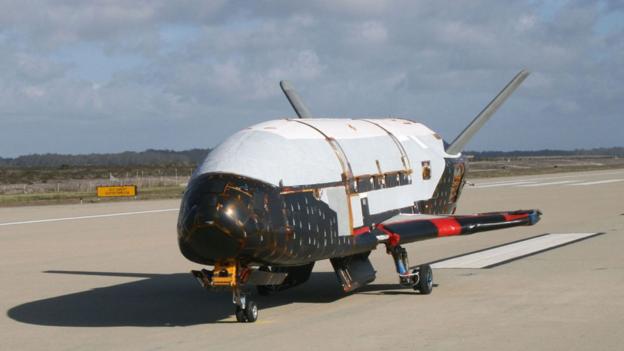| Topic: unmaned russian spaceship falling back to earth | |
|---|---|
|
Round and she goes, where she falls no one knows....

|
|
|
|
|
|
Alleoop stated >>> Round and she goes, where she falls no one knows....  Good Grief; they're always loaded with space station trash and sent back to burn up on re-entry --- and that's what will happen to this billion dollar pay load as well! So before you run around crying 'the sky is falling' or hiding in that 'fallout shelter' --- it's going to be OK! LMAO |
|
|
|
|
|
FYI the aging Space Shuttle Program: for those that need so desperately to be informed {cause there are obviously some that are way behind in that thought process}...
Last November, NASA took decisive action on its two-and-a-half-year-old plan to replace the aging space shuttle. It cut the heart out of the project. Space Shuttle: The Next Generation Even if it's fixed, the disaster-prone Shuttle may not be allowed to fly as long as NASA requires. The agency's plans to replace it are in disarray. But there are concepts on the drawing board. By Bill Sweetman Posted April 15, 2003 Abruptly and quietly, NASA scrapped the shuttle-replacement portion of its so-called Space Launch Initiative (SLI)--the latest in a string of development programs conceived in the wake of the 1986 Challenger disaster--and shifted most of the nearly $5 billion the agency had already earmarked for the program to pay for current shuttle improvements. Among them: safety upgrades that it hoped would let the shuttle fly accident-free until 2020 or beyond. And with plans for a new shuttle on hold, NASA announced that SLI would focus mostly on building an Orbital Space Plane, a modest, relatively inexpensive reusable vehicle that could hold a small crew (and little else) and would be launched by an expendable rocket. NASA hopes that when OSP is ready in 2010, it will serve as an interim, alternative transport, a "space taxi" until the agency can produce a next-generation shuttle. NASA's decision was a last resort. The agency's latest estimates for designing and building a new shuttle had mushroomed from $6 billion to $35 billion. And even that was only a best guess, says Garry Lyles, NASA's Next Generation Launch Technology program manager. The gap between the figures, Lyles says, reflects NASA's difficulty with budget forecasts: "We need to develop a technology program that provides accurate data for our cost models." While so much uncertainty surrounded SLI's price tag, the shuttle's cost--$500 million per launch--was at least a known quantity. Consequently, NASA officials believed they had no choice but to place yet another bet on the 30-year-old system. But three months later, Columbia broke up on reentry, killing its crew of seven, and the agency's decision to shelve the new shuttle program took on a troubling cast. The three surviving shuttles are now grounded, and when they fly again, they'll cost more to operate than before. Safety, maintenance and inspection protocols will be added, and because there's one fewer shuttle the total number of flights will be reduced while fixed personnel and infrastructure costs remain the same. The upshot: With so many economic and engineering questions weighing on the shuttle concept, NASA's plans to fly it for another 20 years suddenly smacks of blind optimism. http://www.popsci.com/military-aviation-space/article/2003-04/space-shuttle-next-generation And there's this report from 1999... What Lies Ahead For Aging Space Shuttle? January 13, 1999|By Michael Cabbage of The Sentinel Staff CAPE CANAVERAL - Pour money into a dependable but older family car or save for a new one? Space policymakers soon could be faced with a similar choice. A 72-page report commissioned by NASA and released Tuesday by the National Research Council gave the space agency high marks for the way it plans upgrades to the aging shuttle fleet. But the study was less enthusiastic about some of the specific improvements proposed, including a couple that have been under development for years. Two questions, experts suggested, should be considered before tackling any costly, future modifications: How likely is a replacement for the shuttle in the near future? What would the shuttle be used for after the projected end of the International Space Station era in 2013? ``If they can develop a brand new vehicle that satisfies all of the requirements, they should do that,'' said Bryan O'Connor, an aerospace consultant and former astronaut who headed the 11-member committee. ``If we wind up flying the shuttle out to 2030, but we've never really decided to do that, then the major cost savings and performance improvement upgrades will never be done. We'll kind of limp out to 2030.'' ``If the technology doesn't pan out,'' he said, ``then certainly they ought to extend the shuttle out.'' Minor shuttle modifications to improve safety and support flights continue to take place. But big-ticket renovations that would improve the shuttle's capabilities and make some basic changes have been mostly on hold since 1995. http://articles.orlandosentinel.com/1999-01-13/news/9901130072_1_shuttle-international-space-station-nasa Some have argued that instead of riding those work horses into the ground and over loading their payloads with heavier shipments to the International Space Station as originally planned the NASA design crew should have had something ready to replace those 'work horses' with and yet they didn't --- WHY? That's what Americans ought to be asking Northrup Drummond - where did all that contractual money go that they received from our government to do that with? But as with most things political; the head hunting only goes as far & deep as who is seated in the current POTUS not the era of the NASA's minutes and the data from their own meetings about the aging shuttle program! So by 2003 NASA had NOTHING to show what they needed - nothing on the drawing boards - nothing in the works; and hell yes, they got budget cuts --- BIG SHOCKER!!! |
|
|
|
|
|
FYI the aging Space Shuttle Program: for those that need so desperately to be informed {cause there are obviously some that are way behind in that thought process}... Last November, NASA took decisive action on its two-and-a-half-year-old plan to replace the aging space shuttle. It cut the heart out of the project. Space Shuttle: The Next Generation Even if it's fixed, the disaster-prone Shuttle may not be allowed to fly as long as NASA requires. The agency's plans to replace it are in disarray. But there are concepts on the drawing board. By Bill Sweetman Posted April 15, 2003 Abruptly and quietly, NASA scrapped the shuttle-replacement portion of its so-called Space Launch Initiative (SLI)--the latest in a string of development programs conceived in the wake of the 1986 Challenger disaster--and shifted most of the nearly $5 billion the agency had already earmarked for the program to pay for current shuttle improvements. Among them: safety upgrades that it hoped would let the shuttle fly accident-free until 2020 or beyond. And with plans for a new shuttle on hold, NASA announced that SLI would focus mostly on building an Orbital Space Plane, a modest, relatively inexpensive reusable vehicle that could hold a small crew (and little else) and would be launched by an expendable rocket. NASA hopes that when OSP is ready in 2010, it will serve as an interim, alternative transport, a "space taxi" until the agency can produce a next-generation shuttle. NASA's decision was a last resort. The agency's latest estimates for designing and building a new shuttle had mushroomed from $6 billion to $35 billion. And even that was only a best guess, says Garry Lyles, NASA's Next Generation Launch Technology program manager. The gap between the figures, Lyles says, reflects NASA's difficulty with budget forecasts: "We need to develop a technology program that provides accurate data for our cost models." While so much uncertainty surrounded SLI's price tag, the shuttle's cost--$500 million per launch--was at least a known quantity. Consequently, NASA officials believed they had no choice but to place yet another bet on the 30-year-old system. But three months later, Columbia broke up on reentry, killing its crew of seven, and the agency's decision to shelve the new shuttle program took on a troubling cast. The three surviving shuttles are now grounded, and when they fly again, they'll cost more to operate than before. Safety, maintenance and inspection protocols will be added, and because there's one fewer shuttle the total number of flights will be reduced while fixed personnel and infrastructure costs remain the same. The upshot: With so many economic and engineering questions weighing on the shuttle concept, NASA's plans to fly it for another 20 years suddenly smacks of blind optimism. http://www.popsci.com/military-aviation-space/article/2003-04/space-shuttle-next-generation And there's this report from 1999... What Lies Ahead For Aging Space Shuttle? January 13, 1999|By Michael Cabbage of The Sentinel Staff CAPE CANAVERAL - Pour money into a dependable but older family car or save for a new one? Space policymakers soon could be faced with a similar choice. A 72-page report commissioned by NASA and released Tuesday by the National Research Council gave the space agency high marks for the way it plans upgrades to the aging shuttle fleet. But the study was less enthusiastic about some of the specific improvements proposed, including a couple that have been under development for years. Two questions, experts suggested, should be considered before tackling any costly, future modifications: How likely is a replacement for the shuttle in the near future? What would the shuttle be used for after the projected end of the International Space Station era in 2013? ``If they can develop a brand new vehicle that satisfies all of the requirements, they should do that,'' said Bryan O'Connor, an aerospace consultant and former astronaut who headed the 11-member committee. ``If we wind up flying the shuttle out to 2030, but we've never really decided to do that, then the major cost savings and performance improvement upgrades will never be done. We'll kind of limp out to 2030.'' ``If the technology doesn't pan out,'' he said, ``then certainly they ought to extend the shuttle out.'' Minor shuttle modifications to improve safety and support flights continue to take place. But big-ticket renovations that would improve the shuttle's capabilities and make some basic changes have been mostly on hold since 1995. http://articles.orlandosentinel.com/1999-01-13/news/9901130072_1_shuttle-international-space-station-nasa Some have argued that instead of riding those work horses into the ground and over loading their payloads with heavier shipments to the International Space Station as originally planned the NASA design crew should have had something ready to replace those 'work horses' with and yet they didn't --- WHY? That's what Americans ought to be asking Northrup Drummond - where did all that contractual money go that they received from our government to do that with? But as with most things political; the head hunting only goes as far & deep as who is seated in the current POTUS not the era of the NASA's minutes and the data from their own meetings about the aging shuttle program! So by 2003 NASA had NOTHING to show what they needed - nothing on the drawing boards - nothing in the works; and hell yes, they got budget cuts --- BIG SHOCKER!!! so whats this have to do with obarry essentially closing down NASA? |
|
|
|
|
|
FYI the aging Space Shuttle Program: for those that need so desperately to be informed {cause there are obviously some that are way behind in that thought process}... Last November, NASA took decisive action on its two-and-a-half-year-old plan to replace the aging space shuttle. It cut the heart out of the project. Space Shuttle: The Next Generation Even if it's fixed, the disaster-prone Shuttle may not be allowed to fly as long as NASA requires. The agency's plans to replace it are in disarray. But there are concepts on the drawing board. By Bill Sweetman Posted April 15, 2003 Abruptly and quietly, NASA scrapped the shuttle-replacement portion of its so-called Space Launch Initiative (SLI)--the latest in a string of development programs conceived in the wake of the 1986 Challenger disaster--and shifted most of the nearly $5 billion the agency had already earmarked for the program to pay for current shuttle improvements. Among them: safety upgrades that it hoped would let the shuttle fly accident-free until 2020 or beyond. And with plans for a new shuttle on hold, NASA announced that SLI would focus mostly on building an Orbital Space Plane, a modest, relatively inexpensive reusable vehicle that could hold a small crew (and little else) and would be launched by an expendable rocket. NASA hopes that when OSP is ready in 2010, it will serve as an interim, alternative transport, a "space taxi" until the agency can produce a next-generation shuttle. NASA's decision was a last resort. The agency's latest estimates for designing and building a new shuttle had mushroomed from $6 billion to $35 billion. And even that was only a best guess, says Garry Lyles, NASA's Next Generation Launch Technology program manager. The gap between the figures, Lyles says, reflects NASA's difficulty with budget forecasts: "We need to develop a technology program that provides accurate data for our cost models." While so much uncertainty surrounded SLI's price tag, the shuttle's cost--$500 million per launch--was at least a known quantity. Consequently, NASA officials believed they had no choice but to place yet another bet on the 30-year-old system. But three months later, Columbia broke up on reentry, killing its crew of seven, and the agency's decision to shelve the new shuttle program took on a troubling cast. The three surviving shuttles are now grounded, and when they fly again, they'll cost more to operate than before. Safety, maintenance and inspection protocols will be added, and because there's one fewer shuttle the total number of flights will be reduced while fixed personnel and infrastructure costs remain the same. The upshot: With so many economic and engineering questions weighing on the shuttle concept, NASA's plans to fly it for another 20 years suddenly smacks of blind optimism. http://www.popsci.com/military-aviation-space/article/2003-04/space-shuttle-next-generation And there's this report from 1999... What Lies Ahead For Aging Space Shuttle? January 13, 1999|By Michael Cabbage of The Sentinel Staff CAPE CANAVERAL - Pour money into a dependable but older family car or save for a new one? Space policymakers soon could be faced with a similar choice. A 72-page report commissioned by NASA and released Tuesday by the National Research Council gave the space agency high marks for the way it plans upgrades to the aging shuttle fleet. But the study was less enthusiastic about some of the specific improvements proposed, including a couple that have been under development for years. Two questions, experts suggested, should be considered before tackling any costly, future modifications: How likely is a replacement for the shuttle in the near future? What would the shuttle be used for after the projected end of the International Space Station era in 2013? ``If they can develop a brand new vehicle that satisfies all of the requirements, they should do that,'' said Bryan O'Connor, an aerospace consultant and former astronaut who headed the 11-member committee. ``If we wind up flying the shuttle out to 2030, but we've never really decided to do that, then the major cost savings and performance improvement upgrades will never be done. We'll kind of limp out to 2030.'' ``If the technology doesn't pan out,'' he said, ``then certainly they ought to extend the shuttle out.'' Minor shuttle modifications to improve safety and support flights continue to take place. But big-ticket renovations that would improve the shuttle's capabilities and make some basic changes have been mostly on hold since 1995. http://articles.orlandosentinel.com/1999-01-13/news/9901130072_1_shuttle-international-space-station-nasa Some have argued that instead of riding those work horses into the ground and over loading their payloads with heavier shipments to the International Space Station as originally planned the NASA design crew should have had something ready to replace those 'work horses' with and yet they didn't --- WHY? That's what Americans ought to be asking Northrup Drummond - where did all that contractual money go that they received from our government to do that with? But as with most things political; the head hunting only goes as far & deep as who is seated in the current POTUS not the era of the NASA's minutes and the data from their own meetings about the aging shuttle program! So by 2003 NASA had NOTHING to show what they needed - nothing on the drawing boards - nothing in the works; and hell yes, they got budget cuts --- BIG SHOCKER!!! Actually, that is not what happened or how it happened. The plans offered by NASA have changed from time to time but usually due to political pressure. Bush was going to be known as the president who sent the US to Mars and one of the first things Obama did was shift about seven billion dollars from manned spaceflight to inner city (mostly Chicago from what I understand) children programs. (Perhaps those ten year olds in Baltimore at that time were the sixteen year olds burning down the city now). In any case, about 10,000 engineers and other workers were laid off at the Houston Manned Spacecraft Center where I worked. The follow up program to the space shuttle was a complex overlapping system (typical of government) that involved the use of a new smaller shuttle, heavy lift rockets, and a larger, multi purpose capsule. Obama killed the plan. If you read the following article you will see that the shuttle program is actually different than what most of the public sees and hears. The military version of "Space Travel" is not totally public. http://www.cbsnews.com/news/military-space-plane-lands-after-secret-mision/ If you pay close attention to the timeline described in the above article you see abilities not factored into public news.  If you "read between the lines" of the article you can guess at what is not said. One thing is for sure. Obama ended NASA going to Mars. 
|
|
|
|
|
|
Edited by
2OLD2MESSAROUND
on
Sun 05/03/15 04:20 PM
|
|
|
metalwing stated >>> Actually, that is not what happened or how it happened. The plans offered by NASA have changed from time to time but usually due to political pressure. Bush was going to be known as the president who sent the US to Mars and one of the first things Obama did was shift about seven billion dollars from manned spaceflight to inner city (mostly Chicago from what I understand) children programs. (Perhaps those ten year olds in Baltimore at that time were the sixteen year olds burning down the city now). In any case, about 10,000 engineers and other workers were laid off at the Houston Manned Spacecraft Center where I worked. The follow up program to the space shuttle was a complex overlapping system (typical of government) that involved the use of a new smaller shuttle, heavy lift rockets, and a larger, multi purpose capsule. Obama killed the plan. If you read the following article you will see that the shuttle program is actually different than what most of the public sees and hears. The military version of "Space Travel" is not totally public. http://www.cbsnews.com/news/military-space-plane-lands-after-secret-mision/ If you pay close attention to the timeline described in the above article you see abilities not factored into public news.  If you "read between the lines" of the article you can guess at what is not said. One thing is for sure. Obama ended NASA going to Mars.  Well, in order to view what you saw happening and what relatives that live on NASA's base in Florida's launch site were working on during those shifts in contractor issues and what areas were going to be maintained as the 'Shuttle Mission' was shut down {see both my inserts above} the time line started back prior to both GWB & Obama tenure as POTUS; but it appears that the 'BLAME GAME' is the only thing that makes some members happy and the reality is the SHUTTLE MISSION was AGEING OUT! Nothing happens in a vacuum or in a blink of an eye; staging this endeavor started long before GWB was ever aware that the shuttles were aging faster then the maintenance crews could keep them 'patched and put back into service'...was this ever made public - HELL NO, not until that horrid disaster and we lost an entire crew 2003...secrets and escalating costs! But for all of you 'I HATE OBAMA' humans there's nothing any of this data is going to do but just put more info out there for you to ignore and that's obvious! I'll withdraw and let those that enjoy their 'HATE' to wallow in it --- I'll just walk away! With NASA's Shuttle Era Ending, Layoffs Loom for Space Workers by Denise Chow, SPACE.com Staff Writer|June 30, 2011 05:19pm ET HOUSTON — As NASA winds down its space shuttle program, the agency is navigating a tricky transition that will not only ground the orbiter fleet for good, but will also mark a huge shift for the thousands of shuttle workers who have spent decades working in the iconic program. After flying one final shuttle mission — which begins with the July 8 launch of shuttle Atlantis — NASA will officially retire its three-orbiter fleet, instead relying on international partners and private spaceship builders to ferry supplies and crews to the International Space Station. The agency is shifting its focus to exploration missions that push deeper into space, such as to an asteroid or Mars. But for many shuttle workers, the very last flight of the 30-year shuttle program will truly be the beginning of the end. NASA expects to undergo a big round of layoffs that will significantly reduce the shuttle workforce, which currently stands at about 6,700 people, said John Shannon, NASA's shuttle program officer. "It's tough to break up a team that has performed so well for so long," Shannon said today (June 30) in a preflight news briefing at the Johnson Space Center in Houston. "Right now we're down to those required just for sustained engineering and operations." Atlantis and its four-astronaut crew are slated to launch on July 8 at 11:26 a.m. EDT (1526 GMT). The shuttle will fly a 12-day mission to the International Space Station to deliver crucial supplies to the orbiting outpost. Currently there are about 5,500 contracted employees spread across Texas, Utah, Louisiana and Alabama, and just less than 1,200 civil servants working on the shuttle, Shannon said. If Atlantis launches on time on July 8, the agency will lay off about 3,200 contractors on July 22, officials said. http://www.space.com/12133-space-shuttle-program-nasa-future-layoffs.html BTW - like flying to 'MARS' was going to be a rational option when we have a aging International Space Station that is needing dire repairs and replacement ASAP and nothing seems imminent without first establishing a base station on the MOON before venturing out into deep space; but that's just IMHO! |
|
|
|
|
|
An out-of-control Russian cargo ship is headed for a destructive plunge into Earth's atmosphere overnight between Thursday and Friday (May 7-8), with satellite watchers around the world trying to pinpoint the exact time and place of the craft's fall from space.
Related Stories The uncrewed Progress 59 spacecraft has been falling to Earth since just after its launch last week on April 28 on a mission to deliver nearly 3 tons of supplies to the International Space Station. In a statement released today (May 7), the Russian space agency Roscosmos said that Progress 59 "will cease to exist" on Friday, adding that they would release updates on the time of re-entry for the spacecraft. "The ESA space debris team re-entry predictions now show the re-entry window has shrunk to include just the night of Thursday/Friday, 7/8 May," European Space Agency spokesman Daniel Scuka wrote in an update today. "We can exclude any time after early Friday morning. There are some first indications that the likelihood for a re-entry over North America or Europe has dropped significantly." The problems with Progress 59 began shortly after liftoff, when the spacecraft experienced technical difficulties – perhaps due to a malfunctioning Soyuz rocket third stage. Video from a camera on Progress 59 showed the craft to be spinning, leaving Russian ground controllers unable to command the vehicle as it tumbled through space. Since then, Russia's State Commission for manned space complex flight tests has formed a board to review the Progress supply craft mishap. The conclusions are expected to be made by May 13, according to Roscosmos. View gallery Out-of-Control Russian Spacecraft Will Fall from Space … Russia's unmanned Progress 59 spacecraft is seen being prepared for its April 28, 2015 launch. T … Tracking Progress 59 in space Veteran satellite observer Ted Molczan of Canada places the re-entry of the Progress as occurring later tonight, May 7, at about 10:03 p.m. EDT (0203 May 8 GMT) as of Thursday afternoon. The uncertainty is 1.9 hours, Molczan said, given a number of factors, including the influence of space weather and its impact on the density of Earth's atmosphere. "It is impossible to know enough about the recent and future state of the spacecraft and the space environment to make precise predictions," Molczan told Space.com. "The challenge seems not unlike that faced by meteorologists attempting to predict the landfall of a hurricane." The public can track the path of Progress 59 online via a satellite-tracking website like Heaven's Above or ny2o.com. The n2yo.com has created a special webpage for Progress 59 that features multiple views of the spacecraft's path. You can also follow Progress 59's path in the map below, as shown by ny2o.org: Progress 59: Lost in space It is likely that some leftovers of Progress 59 will survive the fiery dive through Earth's atmosphere and reach the surface, said Holger Krag, Head of ESA's Space Debris Office at the European Space Operations Center in Darmstadt, Germany. View gallery Out-of-Control Russian Spacecraft Will Fall from Space … The falling Russian spacecraft Progress 59 is seen streaking overhead in this view from the Brazilia … "With every re-entry of a large structure from space you can expect a small fraction to survive," Krag has told Space.com. But there is an extremely small probability that somebody would be injured from the fall of debris, he added. [6 Biggest Spacecraft to Fall Uncontrolled from Space] According to the Russian aerospace company RSC Energia – which built the spacecraft – Progress 59 is carrying propellant components, compressed oxygen, additional equipment that was needed to "maintain the station in good working order," equipment for science experiments, medical supplies, personal belongings and food for the crew. Altogether more than 5,200 lbs. (2,359 kg) of cargo is packed inside Progress 59, including 3,075 lbs. (1,395 kg) of dry cargo, 1,089 lbs. (494 kg) of propellant, 925 lbs. (420 kg) of water and 110 lbs. (50 kg) of compressed gases. The International Space Station is not in any danger of running out of supplies due to the loss of the spacecraft, NASA officials and the station's astronaut crew have said. Progress 59 is also known in Russia as Progress M-27M, and is one of RSC Energia's Progress M-M spacecraft series, an upgraded version of the previous Progress M-series line. According to RSC Energia representatives, Progress 59 is equipped with new devices for the motion control and navigation system and an improved onboard measurement system. All the devices are built around state-of-the-art electronic components and run the latest software. The upgrade made it possible to reduce the mass of the onboard equipment and thus enhance the capability to deliver payload to orbit. |
|
|
|
|










